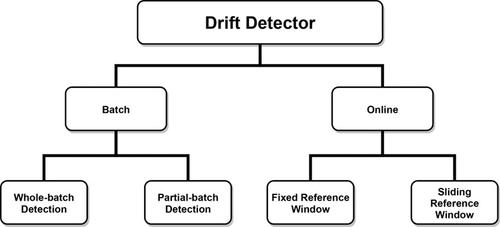当前位置:
X-MOL 学术
›
WIREs Data Mining Knowl. Discov.
›
论文详情
Our official English website, www.x-mol.net, welcomes your feedback! (Note: you will need to create a separate account there.)
An overview of unsupervised drift detection methods
WIREs Data Mining and Knowledge Discovery ( IF 7.8 ) Pub Date : 2020-07-21 , DOI: 10.1002/widm.1381 Rosana Noronha Gemaque 1, 2 , Albert França Josuá Costa 1, 3 , Rafael Giusti 1 , Eulanda Miranda Santos 1
WIREs Data Mining and Knowledge Discovery ( IF 7.8 ) Pub Date : 2020-07-21 , DOI: 10.1002/widm.1381 Rosana Noronha Gemaque 1, 2 , Albert França Josuá Costa 1, 3 , Rafael Giusti 1 , Eulanda Miranda Santos 1
Affiliation

|
Practical applications involving big data, such as weather monitoring, identification of customer preferences, Internet log analysis, and sensors warnings require challenging data analysis, since these are examples of problems whose data are generated in streams and usually demand real‐time analytics. Patterns in such data stream problems may change quickly. Consequently, machine learning models that operate in this context must be updated over time. This phenomenon is called concept drift in machine learning and data mining literature. Several different directions have been pursued to learn from data stream and to deal with concept drift. However, most drift detection methods consider that an instance's class label is available right after its prediction, since these methods work by monitoring the prediction results of a base classifier or an ensemble of classifiers. Nevertheless, this constraint is unrealistic in several practical problems. To cope with this constraint, some works are focused on proposing efficient unsupervised or semi‐supervised concept drift detectors. While interesting and recent overview papers dedicated to supervised drift detectors have been published, the scenario is not the same in terms of unsupervised methods. Therefore, this work presents a comprehensive overview of approaches that tackle concept drift in classification problems in an unsupervised manner. Additional contribution includes a proposed taxonomy of state‐of‐the‐art approaches for concept drift detection based on unsupervised strategies.
中文翻译:

无监督漂移检测方法概述
涉及大数据的实际应用(例如天气监控,客户喜好识别,Internet日志分析和传感器警告)要求进行具有挑战性的数据分析,因为这些都是问题的示例,这些问题的数据是在流中生成的,并且通常需要实时分析。此类数据流问题中的模式可能会迅速改变。因此,在这种情况下运行的机器学习模型必须随时间更新。这种现象在机器学习和数据挖掘文献中称为概念漂移。为了从数据流中学习并解决概念漂移,已经寻求了几种不同的方向。但是,大多数漂移检测方法都认为实例的类别标签在其预测后立即可用,因为这些方法通过监视基本分类器或分类器的组合的预测结果起作用。然而,这种限制在一些实际问题中是不现实的。为了解决这个问题,一些工作集中在提出有效的无监督或半监督概念漂移检测器上。尽管已经发布了有关有监督的漂移检测器的有趣且最新的概述论文,但就无监督方法而言,情况并不相同。因此,这项工作将以无监督的方式全面介绍解决分类问题中概念漂移的方法。其他贡献包括拟议的基于无监督策略的概念漂移检测的最新方法分类法。在一些实际问题中,这种约束是不现实的。为了解决这个问题,一些工作集中在提出有效的无监督或半监督概念漂移检测器上。尽管已经发布了有关有监督的漂移检测器的有趣且最新的概述论文,但就无监督方法而言,情况并不相同。因此,这项工作将以无监督的方式全面介绍解决分类问题中概念漂移的方法。其他贡献包括拟议的基于无监督策略的概念漂移检测的最新方法分类法。在一些实际问题中,这种约束是不现实的。为了解决这个问题,一些工作集中在提出有效的无监督或半监督概念漂移检测器上。尽管已经发布了有关有监督的漂移检测器的有趣且最新的概述论文,但就无监督方法而言,情况并不相同。因此,这项工作将以无监督的方式全面介绍解决分类问题中概念漂移的方法。其他贡献包括拟议的基于无监督策略的概念漂移检测的最新方法分类法。尽管已经发布了有关有监督的漂移检测器的有趣且最新的概述论文,但就无监督方法而言,情况并不相同。因此,这项工作提供了一种以无监督的方式全面解决分类问题中概念漂移的方法的概述。其他贡献包括拟议的基于无监督策略的概念漂移检测的最新方法分类法。尽管已经发布了有关有监督的漂移检测器的有趣且最新的概述论文,但就无监督方法而言,情况并不相同。因此,这项工作将以无监督的方式全面介绍解决分类问题中概念漂移的方法。其他贡献包括拟议的基于无监督策略的概念漂移检测的最新方法分类法。
更新日期:2020-07-21
中文翻译:

无监督漂移检测方法概述
涉及大数据的实际应用(例如天气监控,客户喜好识别,Internet日志分析和传感器警告)要求进行具有挑战性的数据分析,因为这些都是问题的示例,这些问题的数据是在流中生成的,并且通常需要实时分析。此类数据流问题中的模式可能会迅速改变。因此,在这种情况下运行的机器学习模型必须随时间更新。这种现象在机器学习和数据挖掘文献中称为概念漂移。为了从数据流中学习并解决概念漂移,已经寻求了几种不同的方向。但是,大多数漂移检测方法都认为实例的类别标签在其预测后立即可用,因为这些方法通过监视基本分类器或分类器的组合的预测结果起作用。然而,这种限制在一些实际问题中是不现实的。为了解决这个问题,一些工作集中在提出有效的无监督或半监督概念漂移检测器上。尽管已经发布了有关有监督的漂移检测器的有趣且最新的概述论文,但就无监督方法而言,情况并不相同。因此,这项工作将以无监督的方式全面介绍解决分类问题中概念漂移的方法。其他贡献包括拟议的基于无监督策略的概念漂移检测的最新方法分类法。在一些实际问题中,这种约束是不现实的。为了解决这个问题,一些工作集中在提出有效的无监督或半监督概念漂移检测器上。尽管已经发布了有关有监督的漂移检测器的有趣且最新的概述论文,但就无监督方法而言,情况并不相同。因此,这项工作将以无监督的方式全面介绍解决分类问题中概念漂移的方法。其他贡献包括拟议的基于无监督策略的概念漂移检测的最新方法分类法。在一些实际问题中,这种约束是不现实的。为了解决这个问题,一些工作集中在提出有效的无监督或半监督概念漂移检测器上。尽管已经发布了有关有监督的漂移检测器的有趣且最新的概述论文,但就无监督方法而言,情况并不相同。因此,这项工作将以无监督的方式全面介绍解决分类问题中概念漂移的方法。其他贡献包括拟议的基于无监督策略的概念漂移检测的最新方法分类法。尽管已经发布了有关有监督的漂移检测器的有趣且最新的概述论文,但就无监督方法而言,情况并不相同。因此,这项工作提供了一种以无监督的方式全面解决分类问题中概念漂移的方法的概述。其他贡献包括拟议的基于无监督策略的概念漂移检测的最新方法分类法。尽管已经发布了有关有监督的漂移检测器的有趣且最新的概述论文,但就无监督方法而言,情况并不相同。因此,这项工作将以无监督的方式全面介绍解决分类问题中概念漂移的方法。其他贡献包括拟议的基于无监督策略的概念漂移检测的最新方法分类法。


























 京公网安备 11010802027423号
京公网安备 11010802027423号